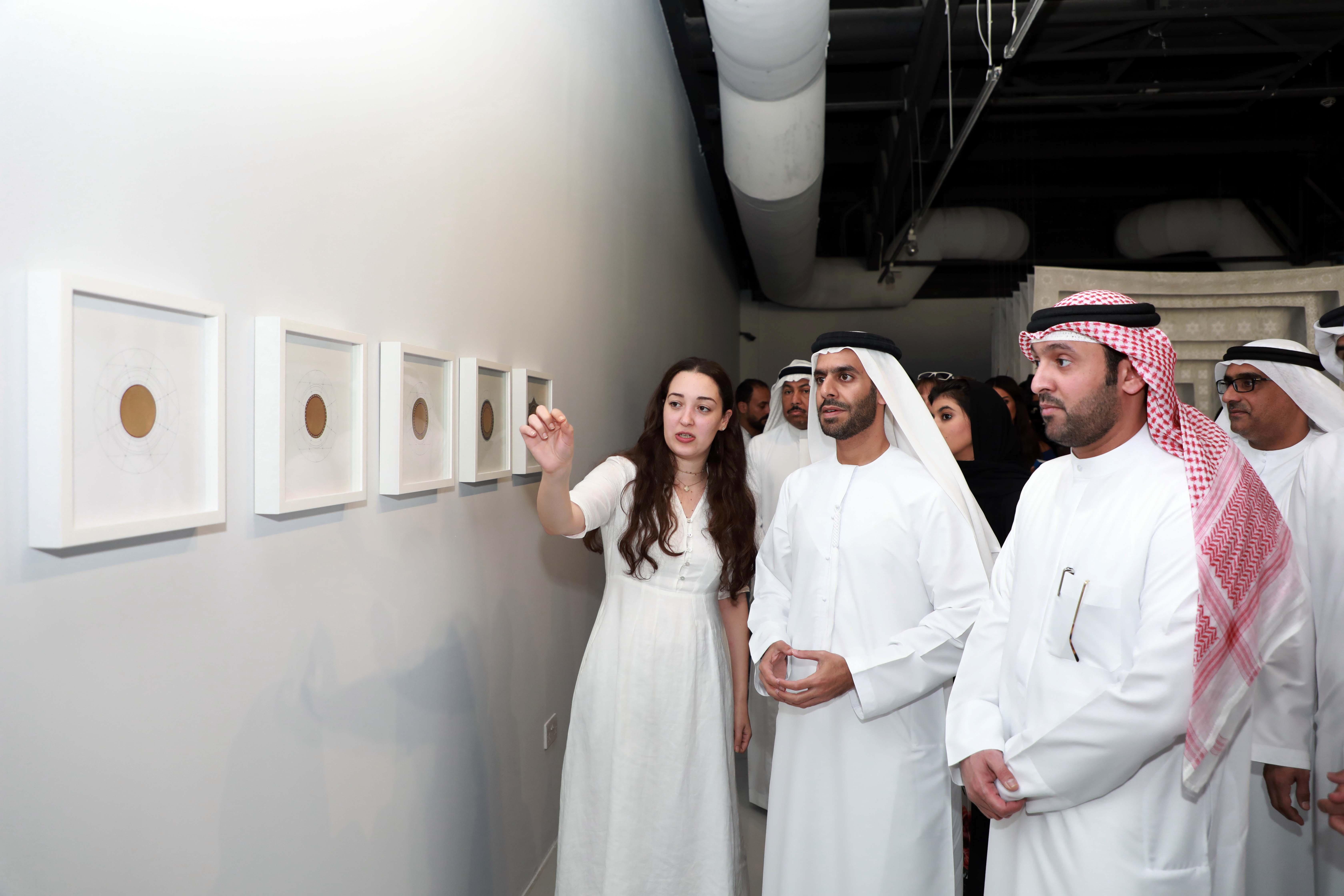Sharjah, UAE’s less glitzy emirate shines for Islamic arts
Photo: Marwan bin Jassim Al Sarkal, executive chairman, Sharjah Investment and Development Authority (Shurooq) and Mohammed Al Qaseer, director of the Cultural Affair of Department of Culture and general coordinator of the Sharjah Islamic Arts Festival, being shown around an exhibition at Maraya Art Centre on 20th December 2018. Photo Supplied by Sharjah Department of Culture.
In the United Arab Emirates, Abu Dhabi and Dubai are globally recognised for arts and culture, with the likes of headliners Louvre Abu Dhabi, Abu Dhabi Art, Art Dubai and Emirates Airline Festival of Literature. But when it comes to Islamic arts, the country’s most celebrated emirates concede to a much less glitzy neighbour.
Sharjah stands its ground as a leading UAE cultural city and the emirate has long built itself as a cultural capital prioritising cultural activity, preserving national culture and arts, and programming “activities that consolidate Arab and Islamic values”.
In 1998 UNESCO awarded it the title of “Cultural Capital of the Arab World” and it has been the only UAE city named to this programme since it started in 1996. Sharjah is also the only UAE city to be named the “Capital of Islamic Culture” by the Organisation of Islamic Cooperation (OIC), when it held that honour for the Arab region in 2014.
Sharjah is home to one of the longest-running dedicated Islamic arts festivals. The Sharjah Islamic Arts Festival was launched twenty-one years ago when it focused on exhibiting traditional and contemporary Islamic arts. It has since evolved into a multi-faceted month-long event with an extensive range of workshops, lectures, exhibitions and public installations.
“Two decades ago, His Highness Sheikh Dr Sultan bin Mohammed Al Qassimi, Member of the Supreme Council, Ruler of Sharjah, set the foundation for the Islamic Arts Festival, and the [21] editions of the festival have seen remarkable artistic accumulation,” Khalid Muslit, head of the media committee at Sharjah’s Department of Culture told Salaam Gateway.
The growth and success of the Sharjah Islamic Arts Festival is a result of expanding the exhibitions into different venues across the emirate, involving the public through site-specific installations, as well as the high calibre of artists that are nominated and selected every year, according to Muslit.
The 21st edition, which ran in the cool winter months from Dec 19 to Jan 19 this year, showed exhibitions at the Sharjah Art Museum, Al Majaz Waterfront, Maraya Art Centre, Sharjah Calligraphy Museum and other locations throughout the emirate. It showed calligraphy, paintings, sculpture and modern art, and explored areas like Islamic numerology.
Completely funded by the government, the festival hosted as many as 377 artworks by 63 artists, who came from countries as close as Saudi Arabia, Iran and Egypt, and as far as Japan and Argentina. They include Emirati artist Fatma Lootah, who has had her paintings displayed in New York's Times Square, London design collective Toy Studio, and a collaborative effort involving Emirati artist, filmmaker and poet Nahjoum Al Ghanem, and British singer-songwriter Sami Yusuf.
The Sharjah authorities are yet to release visitor numbers.
Sharjah’s Department of Culture, which organises the festival, is itself one of the oldest arts and culture-oriented bodies in UAE. A governmental body, it collaborates with numerous entities on coordinating the festival, including Sharjah Investment & Development Authority (SHUROOQ), Sharjah Museums Authority, and the Awqaf Department, according to Muslit.
With an 88-page programme, the latest edition offered hundreds of workshops, lectures and exhibitions and hosted the Gulf Calligraphy Forum for the first time, in cooperation with the Emirates Association of Arabic Calligraphy and Islamic Decoration.
“The festival contains a lot of activities that are not just exhibitions; there were over 161 workshops in calligraphy, Islamic ornamentation, sand-writing, and other subjects, as well as 26 public lectures on Islamic art,” said Muslit.
No two editions are the same. Each year, the Department of Culture adopts a different theme to unite the artists and to encourage new interpretations of Islamic culture and art.
The 21st edition addressed the theme of ‘Horizon’, to encourage artists to expand their horizons and create a discourse shaped by their inspiration of Islamic art, according to Mohammed Al Qaseer, director of the Department of Culture and general coordinator of the Sharjah Islamic Arts Festival.
Previous themes have included 'bunyan', the Arabic word for ‘standing structure’ or ‘man-built creation’. With this theme, the organisers wanted to focus on the creativity underlying the process of any construction, to deconstruct the concept of 'bunyan' and to rebuild a visual discourse in the realm of contemporary Islamic art.
“After 20 years, Sharjah Islamic Arts Festival has asserted its credibility in recasting the light upon this ancient art, to reach a significant position in the arena of international contemporary art,” said Muslit.
Along with other initiatives by the Department of Culture, such as the Sharjah Calligraphy Biennial and the Arabic Poetry Forum, Sharjah Islamic Arts Festival has reinforced the emirate’s position as an Islamic arts and culture hub.
“Today, the festival is one of the most renowned Islamic art events in the region,” added Muslit.
(Reporting by Heba Hashem; Editing by Emmy Abdul Alim emmy.alim@refinitiv.com)
© SalaamGateway.com 2019 All Rights Reserved
